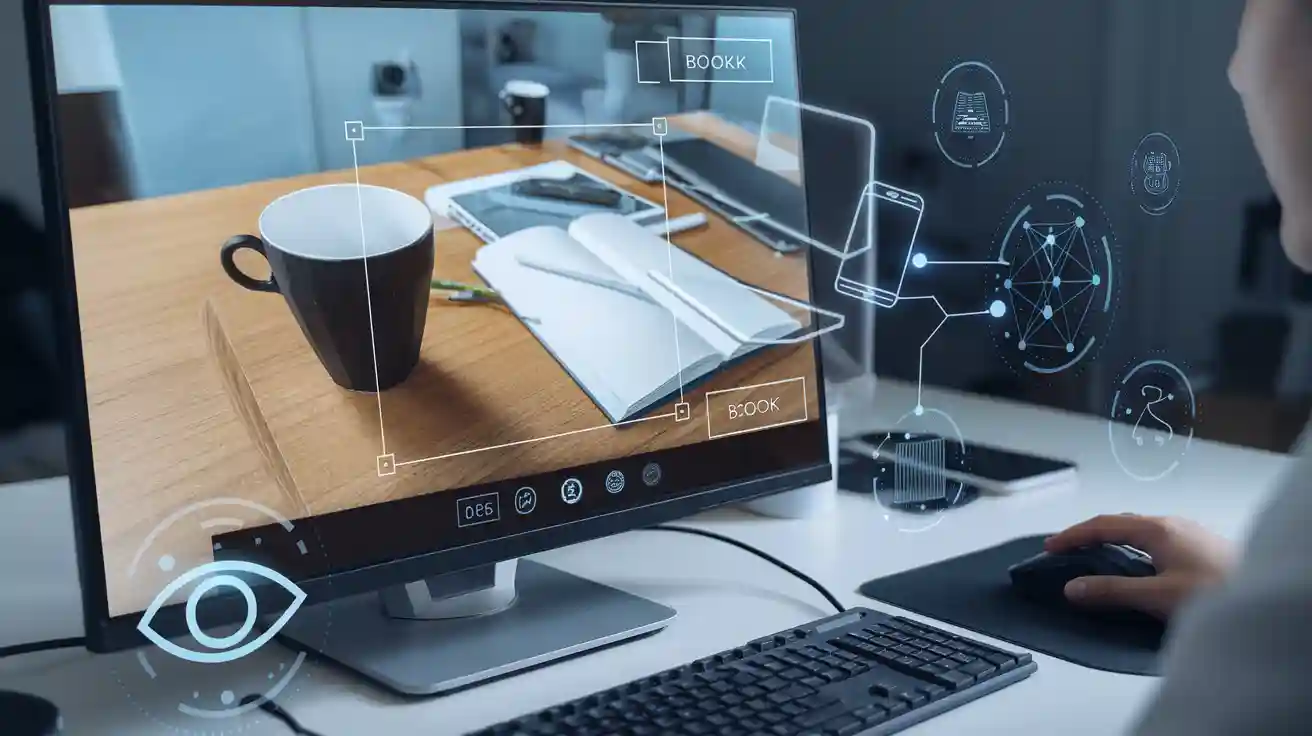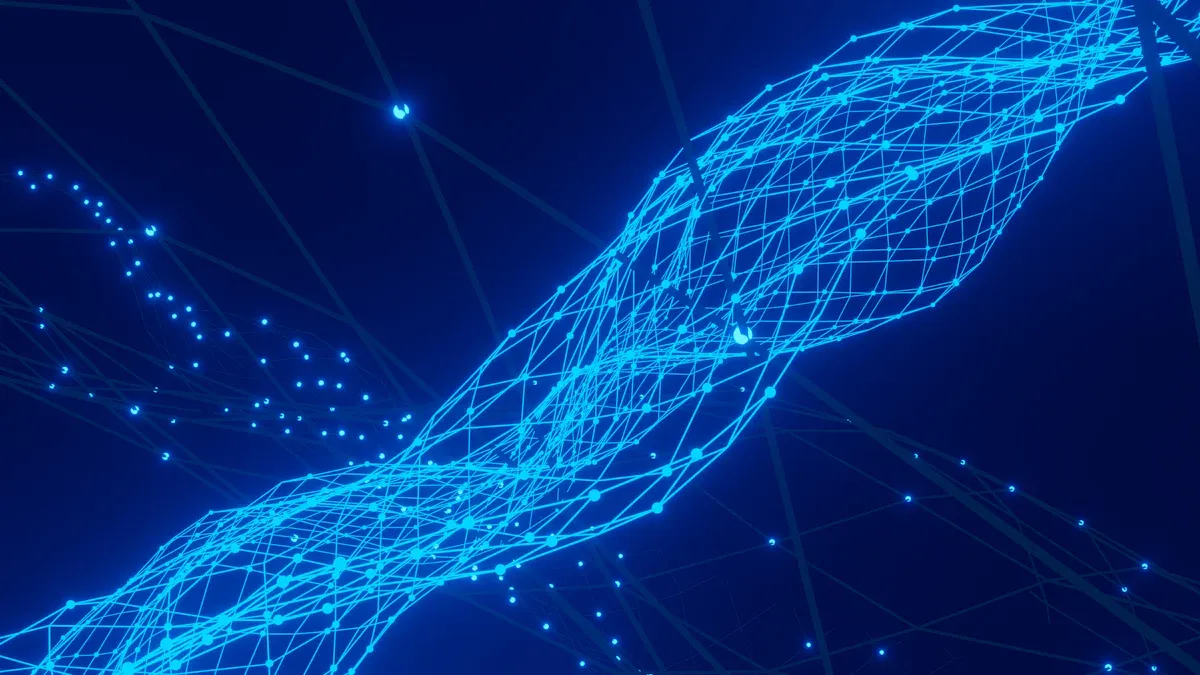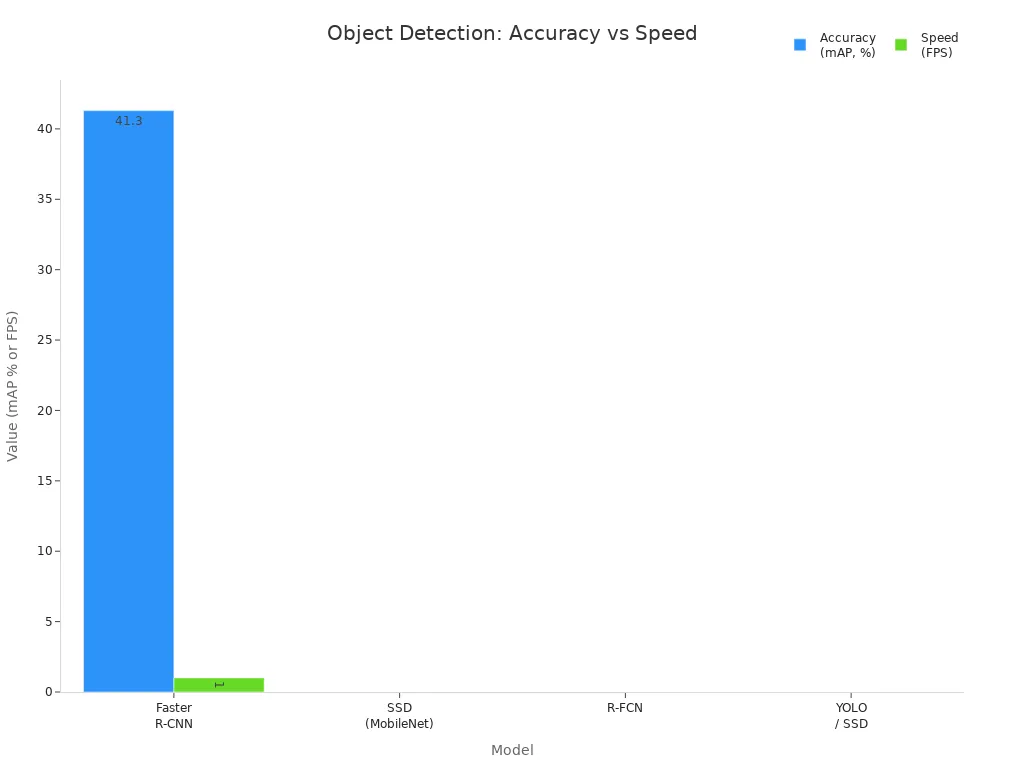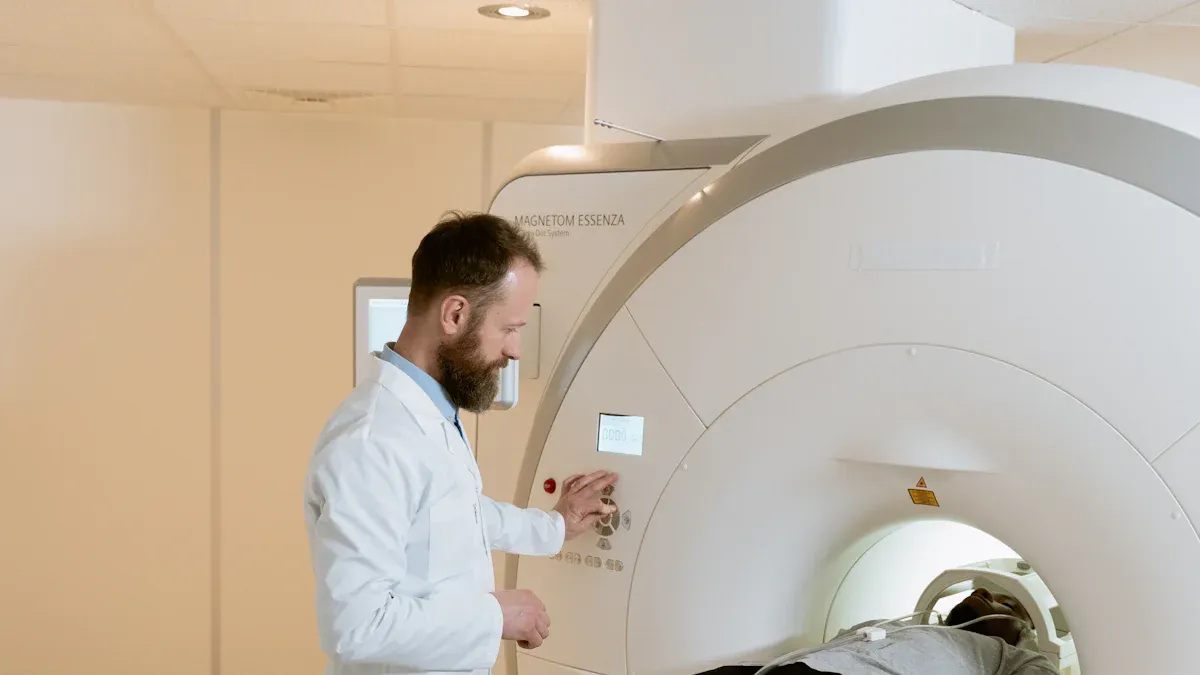
An object detection machine vision system uses computer vision to identify and locate objects in images or videos. These machine vision systems allow machines to interpret visual data and make decisions. Object detection plays a key role in computer vision by helping machines find and track items, count products, or spot defects. In factories, machine vision systems with object detection improve quality control and reduce errors. They can catch tiny flaws that people might miss and work faster than manual checks.
The object detection system market reached USD 9,170 million in 2024 and is expected to grow to nearly USD 16 billion by 2032, driven by industries like automotive, electronics, and food & beverage.
Machine vision systems use deep learning and computer vision to deliver real-time results. These systems support automation, boost efficiency, and help companies meet high standards. Leading companies like BMW and Amazon use object detection machine vision system technology for tasks such as defect detection and warehouse management.
| Aspect | Details |
|---|---|
| Market Size (2024) | USD 9,170 million |
| Projected Market Size (2032) | USD 15,992.91 million |
| CAGR (2024-2032) | 7.2% |
| Leading Regions | North America (35% market share), Europe |
| Fastest Growing Region | Asia-Pacific (China, Japan, South Korea, India) |
| Key Industry Sectors | Automotive, Electronics, Semiconductors, Pharmaceuticals, Food & Beverage, Logistics, Warehouse Automation |
| Adoption Drivers | Industry 4.0, AI integration, real-time quality inspection, defect detection (>99% accuracy), process optimization, edge computing |
| Cost Trends | Declining component costs making systems accessible to SMEs |
Key Takeaways
- Object detection helps machines find and identify objects in images or videos, enabling smarter and faster decisions in many industries.
- Machine vision systems combine cameras, lighting, sensors, and software to capture and analyze images accurately for tasks like quality control and safety.
- Deep learning models like YOLO and SSD allow real-time object detection, making automation and safety improvements possible in factories, robotics, and vehicles.
- Object detection supports diverse applications including industrial automation, healthcare diagnostics, robotics guidance, and assistive technology for people with disabilities.
- Trends like edge computing and sensor fusion improve speed, privacy, and accuracy, shaping the future of object detection in complex environments.
Object Detection Machine Vision System
What Is Object Detection?
Object detection helps machines find and identify objects in images or videos. This process combines object recognition, which tells what the object is, and object localization, which shows where the object is. An object detection machine vision system uses computer vision to analyze visual data and make decisions. These systems rely on object detection algorithms and object detection models to spot multiple items at once, even in busy scenes.
Object detection plays a key role in many industries. For example, autonomous vehicles use object detection to find lanes, pedestrians, and obstacles. In healthcare, doctors use computer vision solutions to detect tumors or fractures in medical images. Retail stores use object detection to track products, manage inventory, and check for packaging defects. Object detection systems also support real-time surveillance and quality control in factories and warehouses.
Object detection allows machine vision systems to understand their environment. This leads to smarter, safer, and more efficient processes in many fields.
Machine Vision Systems Overview
Machine vision systems use computer vision to help machines "see" and understand the world. These systems come in different types based on how they capture and process images:
- 1D Machine Vision Systems: These systems scan images line by line. They work well for inspecting materials like paper, textiles, or wires moving on a conveyor belt.
- 2D Machine Vision Systems: These systems capture flat images. Most object detection machine vision systems use 2D images for tasks like barcode reading, defect detection, and sorting.
- 3D Machine Vision Systems: These systems create depth maps or 3D models. They help with object localization in complex environments, such as guiding robots or measuring object volume.
Each type of machine vision system supports object detection in different ways. 1D systems focus on simple presence or absence checks. 2D systems handle most object detection tasks, using deep learning and computer vision solutions to find and classify objects. 3D systems add depth information, making object localization more accurate for robotics and automation.
System Components
A typical object detection machine vision system includes several key components. Each part works together to capture, process, and analyze images for object detection and object localization.
| Component | Description |
|---|---|
| Cameras | Capture images or video. High-resolution cameras improve object detection accuracy. |
| Sensors | Trigger image capture or measure distance. Sensors help with object localization and timing. |
| Lighting | Provides the right illumination for clear images. Good lighting is vital for accurate detection. |
| Image Processing Hardware | Handles fast data processing. Hardware supports real-time object detection and deep learning. |
| Image Processing Software | Runs object detection algorithms and object detection models. Software analyzes images and makes decisions. |
Lighting plays a big role in machine vision systems. Different lighting techniques help improve object detection and object localization:
- Backlighting creates a silhouette, making it easier to see edges or check if an object is present.
- Ring Lighting gives even light around the camera, reducing shadows and glare. This works well for small or round parts.
- Coaxial Lighting shines light along the camera’s axis, helping to see shiny objects without glare.
- Diffuse Lighting spreads light softly, reducing shadows and showing surface details.
- Dome Lighting surrounds the object with light from all sides, removing shadows and reflections.
- Dark Field Lighting uses low-angle light to highlight scratches or cracks.
- Bar Lighting uses a straight light source to highlight edges or textures.
- Area Lighting covers large surfaces with even light, useful for general inspections.
- Direct Illumination places light above or beside the object to show surface details and defects.
Deep learning has improved object detection in machine vision systems. Modern computer vision solutions use deep learning to train object detection models that can spot many types of objects quickly and accurately. These systems support real-time object detection, making them valuable for quality control, safety, and automation.
A well-designed object detection machine vision system combines the right hardware, lighting, and software. This setup ensures accurate object recognition and object localization for many computer vision applications.
How Object Detection Works

Traditional Methods
Traditional object detection methods use hand-crafted features and rule-based logic. Engineers design these systems to find patterns in images. They often use edge detection, color histograms, or texture analysis. These methods rely on algorithms like Haar cascades and Histogram of Oriented Gradients (HOG). The system scans the image and looks for specific shapes or patterns. When it finds a match, it draws bounding boxes around the detected objects.
These early computer vision techniques work well for simple tasks. For example, they can detect faces or barcodes in controlled environments. However, they struggle with complex backgrounds or objects that change shape. Traditional object detection algorithms cannot handle large variations in lighting or object orientation. They also have trouble with overlapping objects. As a result, accuracy remains limited, especially in real-world applications.
Deep Learning Object Detection
Deep learning has changed the field of computer vision. Deep learning object detection uses neural networks to learn features directly from data. These systems do not need hand-crafted rules. Instead, they train on thousands of labeled images. The network learns to recognize objects and their locations. Deep learning object detection models use layers of artificial neurons to process visual information.
There are two main types of deep learning object detection algorithms:
- Region-based detectors: These models, such as Faster R-CNN, first propose regions in the image that might contain objects. The system then classifies each region and refines the bounding boxes. Region-based detectors achieve high accuracy. They work well for small objects and complex scenes. However, they run slowly and cannot support real-time applications.
- Single shot detectors: Models like YOLO (You Only Look Once) and SSD (Single Shot MultiBox Detector) predict object classes and bounding boxes in one step. These deep learning object detection models process the entire image at once. They run much faster than region-based detectors. Single shot detectors enable real-time object detection, but they may miss small objects or make more mistakes.
The table below compares popular object detection models by accuracy and speed:
| Model | Accuracy (mAP) | Speed (FPS) / Inference Time | Notes on Object Size Performance |
|---|---|---|---|
| Faster R-CNN (Inception ResNet, 300 proposals) | Highest accuracy (e.g., 41.3% mAP on COCO) | ~1 FPS (slow) | Best for small objects, state-of-the-art accuracy |
| SSD (MobileNet) | Good accuracy among fast models | Real-time capable (fast) | Performs worse on small objects, good on large objects |
| R-FCN (Residual Network) | Balanced accuracy and speed | Faster than Faster R-CNN | Moderate performance overall |
| YOLO / SSD (single shot detectors) | Lower accuracy than Faster R-CNN | Designed for real-time speed | Trade-off: faster but less accurate, especially on small objects |

Deep learning object detection models like YOLO and SSD allow computer vision systems to process images quickly. These models use convolutional neural networks to extract features and predict bounding boxes. They can detect multiple objects in a single image. Deep learning object detection supports many applications, such as self-driving cars, security cameras, and industrial robots.
Deep learning object detection has made computer vision more powerful and flexible. These systems can adapt to new tasks by training on different datasets.
Real-Time Detection
Real-time detection means the system can find and locate objects instantly as images arrive. This ability is important for automation and safety. In factories, real-time object detection checks products on fast-moving conveyor belts. Robots use real-time detection to avoid obstacles and pick up items. Self-driving cars rely on real-time detection to spot pedestrians, vehicles, and road signs.
Deep learning object detection models like YOLO and SSD make real-time detection possible. These models process images at high speeds, sometimes over 30 frames per second. Real-time detection helps computer vision systems make quick decisions. For example, a robot can stop if it sees a person in its path. A quality control system can reject a defective product before it leaves the line.
Real-time object detection depends on fast hardware and efficient algorithms. Engineers use powerful graphics cards and optimized software. They also adjust image resolution and model size to balance speed and accuracy. Deep learning object detection continues to improve, making real-time detection more reliable and accessible.
Real-time detection transforms industries by enabling machines to react instantly to their environment.
Applications

Industrial Automation
Industrial automation relies on computer vision to improve efficiency and safety. Object detection applications in factories include quality inspection, defect detection, and sorting. Automated inspection systems use computer vision to find cracks, scratches, or missing parts on products. They also check if components are assembled correctly. Material and packaging inspection ensures that items meet standards before shipping. Predictive maintenance uses computer vision to monitor equipment for signs of wear. Safety monitoring helps detect hazards and keeps workers safe.
- Defect detection: Finds cracks, scratches, or missing parts.
- Assembly verification: Checks if parts are in the right place.
- Predictive maintenance: Monitors machines for problems.
- Material and packaging inspection: Confirms correct packaging.
- Safety monitoring: Spots hazards in the workplace.
Object detection use cases in industrial automation help reduce waste and improve product quality. Automated inspection systems work faster than manual checks and support real-time decision-making.
Robotics and Guidance
Robots use computer vision applications for navigation and object recognition. Vision-guided robots rely on object detection to pick up items, sort products, and avoid obstacles. Object tracking helps robots follow moving objects on conveyor belts. Person detection and pedestrian detection keep robots from colliding with people. Vehicle detection allows robots to move safely in warehouses and factories. These computer vision applications make robots smarter and more flexible.
Healthcare
Healthcare uses computer vision to analyze medical images. Object detection applications include tumor detection, cancer screening, and automating cell counting. Medical AI diagnostics help doctors find changes in tissue structure. Deep learning models support image segmentation and object recognition in X-rays, CT scans, and pathology slides. These computer vision applications improve diagnostic accuracy and speed. Privacy-preserving techniques and edge AI help keep patient data secure during automated inspection.
- AI tumor detection
- Cancer detection with computer vision
- Medical AI diagnostics
- Automating cell counting
- Detecting tissue structure changes
Assistive Technology
Assistive technology uses computer vision to help people with disabilities. Person detection and pedestrian detection support navigation for visually impaired individuals. Object recognition systems read labels or identify objects in real time. Video surveillance systems use vehicle detection and person detection to improve safety in public spaces. These computer vision applications increase independence and safety for many people.
Computer vision applications in object detection, object recognition, and tracking continue to grow. They support industries from manufacturing to healthcare and help people in daily life.
Comparison with Related Tasks
Classification vs. Object Detection
Image classification and object detection both belong to the field of computer vision. Classification assigns a single label to an entire image. For example, a computer vision system might look at a photo and decide if it shows a cat or a dog. This method works well when only one main object appears in the image.
Object detection goes further. It finds and labels each object in an image. The system draws bounding boxes around items, such as cars, people, or animals. Object detection helps with person detection and tracking in crowded scenes. It allows computer vision systems to count objects, locate them, and follow their movement over time. This approach supports real-world tasks like security monitoring and warehouse automation.
Object detection provides more detailed information than classification. It enables computer vision systems to understand not just what is present, but also where each object appears.
Detection vs. Segmentation
Detection and segmentation both help computer vision systems analyze images, but they produce different outputs. Object detection identifies and localizes objects using bounding boxes. Segmentation divides an image into regions at the pixel level, showing the exact shape and boundary of each object.
The table below highlights the main differences:
| Aspect | Object Detection | Image Segmentation |
|---|---|---|
| Output | Bounding boxes around detected objects | Pixel-level partitioning of image into meaningful regions |
| Detail Level | Coarse localization of objects | Fine-grained information about object boundaries and regions |
| Types | Detects and classifies objects | Semantic segmentation (class per pixel), Instance segmentation (individual objects) |
| Use Cases | Video surveillance, agriculture (crop monitoring, pest detection), retail analytics | Medical image analysis (tumor detection, organ localization), manufacturing defect detection, robotics for precise localization |
| Purpose | Identifying and localizing objects | Understanding object boundaries and regions in detail |
| Application Focus | Object tracking, scene understanding | Precise object localization and detailed spatial understanding |
Segmentation gives computer vision systems a deeper understanding of object shapes. This helps in medical imaging, where doctors need to see the exact outline of a tumor. Object detection works better for tasks like person detection and tracking, where knowing the location and count of people matters most.
Challenges and Trends
Accuracy and Scalability
Object detection faces several challenges in real-world settings. Accuracy often drops when systems encounter new environments or unusual objects. Deep learning models need large, well-annotated datasets to perform well. For example, datasets like SODA, which include nearly 20,000 images and over 286,000 labeled objects, help improve object detection performance. These datasets offer diverse scenes, angles, and weather conditions. They make models more robust and less likely to overfit. However, collecting and labeling such data is expensive and time-consuming. Construction sites, for instance, are chaotic and require expert knowledge for proper annotation. Deep learning algorithms benefit from these datasets, but scaling up remains a challenge.
- Large datasets improve accuracy and generalization.
- Complex environments increase annotation costs.
- Deep learning models need diverse data to avoid overfitting.
Edge Computing
Edge computing has become a key trend in real-time object detection. By processing data closer to the source, edge devices reduce the delay between image capture and decision-making. This approach supports applications that need instant responses, such as industrial robots or autonomous vehicles. Edge computing also helps protect sensitive data by keeping it local. Deep learning models run on specialized hardware at the edge, allowing real-time analysis without sending data to the cloud. This trend makes object detection faster and more secure.
Edge computing enables real-time object detection in environments where speed and privacy matter most.
Future of Object Detection
The future of object detection will see more integration of deep learning and advanced sensors. Recent progress in 3D vision combines LiDAR and cameras to boost detection accuracy, especially in autonomous systems. Sensor fusion improves precision but brings challenges like high costs and complex data processing. Researchers continue to seek better ways to integrate sensors and lower costs. Deep learning will remain central, driving improvements in both accuracy and speed. Ongoing research aims to make object detection systems smarter, more scalable, and ready for even more complex environments.
Machine vision systems now shape many industries by enabling machines to see and act with precision. Advances in deep learning and real-time detection help companies improve safety and efficiency. Professionals can explore more with these recommended books:
| Book Title | Author(s) | Focus Area | Suitable For |
|---|---|---|---|
| Computer Vision: Models, Learning, and Inference | Richard Szeliski | Vision system development | Beginners to advanced |
| Deep Learning for Vision Systems | Mohamed Elgendy | Deep learning, object detection | Intermediate to advanced |
| Learning OpenCV 4 Computer Vision with Python 3 | Joseph Howse, Joe Minichino | OpenCV, tracking | Beginners to intermediate |
Staying informed about new trends and performance metrics, such as precision, recall, and mean average precision, helps professionals build better vision solutions.
FAQ
What is the main difference between object detection and image classification?
Object detection finds and locates many objects in an image. Image classification only tells what is in the whole image. Object detection draws boxes around each item. Classification gives one label for the entire picture.
How do machine vision systems handle poor lighting?
Good lighting helps cameras see objects clearly. Machine vision systems use special lights, like ring or dome lights, to reduce shadows and glare. These lights make detection more accurate, even in dark or shiny environments.
Can object detection work in real time?
Yes, modern systems use fast algorithms like YOLO. These models process images quickly. Real-time detection helps robots and machines react instantly to changes around them.
What industries use object detection the most?
- Automotive
- Electronics
- Food and beverage
- Logistics
- Healthcare
These industries use object detection for quality checks, sorting, safety, and tracking products.
See Also
A Comprehensive Guide To Object Detection In Machine Vision
Essential Principles Behind Edge Detection In Vision Systems
How Image Recognition Impacts Quality Control In Machine Vision








